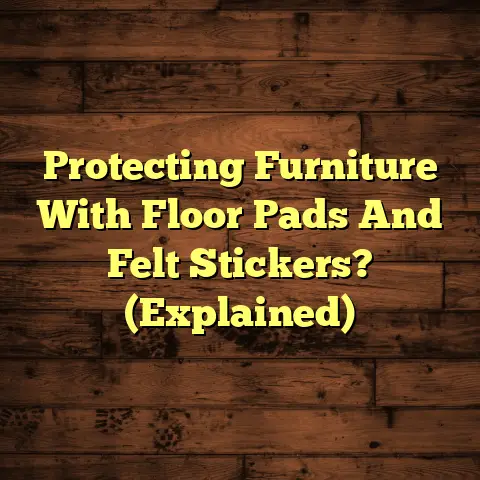What are Carpet Grippers? (7 Install Mistakes!)
(A Flooring Contractor’s Confession)
I’m Mike, and I’ve been wrestling with floors for over 20 years. You might think I’ve seen it all, but flooring always has a way of surprising you.Let me tell you a story. Back when I was just starting out, fresh-faced and full of DIY confidence, I decided to tackle re-carpeting my living room. I picked out this plush, luxurious carpet – a real statement piece, or so I thought. I measured the room (or so I thought!), bought the supplies, and dove in headfirst.
Everything seemed to be going swimmingly… until I got to the carpet grippers, those unassuming little strips that hold everything together. I figured, “How hard can it be?” Slap ’em down, nail ’em in, and boom – carpet heaven, right?
Wrong.
The carpet looked great initially, I will say. But within a few weeks, little ripples started appearing. Then came the waves. Eventually, my “statement piece” looked more like a rumpled bedsheet.
Turns out, I’d made a mess of the gripper installation. I hadn’t prepared the subfloor properly, used the wrong type of gripper, and definitely didn’t leave enough space for expansion.
It was a humbling experience, to say the least. But it taught me a valuable lesson: those little carpet grippers are way more important than they look. That day sparked a deep dive into understanding everything about them, which I’m excited to share with you today!
Ready to avoid my rookie mistakes? Let’s get into it.
Section 1: What Are Carpet Grippers?
So, what exactly are carpet grippers?
In simple terms, they’re thin strips of wood or metal fitted with rows of angled tacks or pins. These strips are installed around the perimeter of a room, close to the walls, and their main purpose is to securely hold your carpet in place.
Think of them as the unsung heroes of carpet installation. They stretch the carpet taut, preventing wrinkles, bunching, and movement. Without them, your carpet is basically just a big rug waiting to slide around.
There are a few different types of carpet grippers out there:
-
Traditional Tack Strips: These are the most common type, usually made of wood with two rows of angled tacks. They’re suitable for most carpet types and subfloors.
-
Metal Gripper Strips: These are more durable than wood and are often used in high-traffic areas or on concrete subfloors.
-
Dual Purpose Grippers: Designed for use where carpet meets a hard floor surface, such as a doorway.
-
Adhesive Grippers: These newer options use strong adhesive to stick to the subfloor. They’re easier to install but might not be as secure as traditional tack strips for thicker carpets.
The materials used in carpet gripper construction also play a big role in their performance. Wood grippers are generally made from plywood or softwood, while metal grippers are typically steel or aluminum. The quality of the tacks is also crucial. You want something that’s strong and won’t bend or break easily.
The impact of these little strips is huge. Without carpet grippers, your carpet is vulnerable. It can develop wrinkles, start to bunch up, and generally look worn and tired way before its time. They are essential for keeping your carpet looking its best for years to come.
Section 2: The Importance of Proper Installation
Okay, so we know what carpet grippers are and what they do. But why is proper installation so darn important?
Well, think of it this way: a chain is only as strong as its weakest link. If your carpet grippers aren’t installed correctly, they won’t be able to do their job properly, and your entire carpet installation will suffer.
Here are some of the potential consequences of improper installation:
-
Carpet Damage: Loose carpet can be easily damaged by foot traffic, furniture, and even vacuum cleaners. Wrinkles and bunches can create weak spots that wear down quickly.
-
Safety Hazards: Loose carpet is a tripping hazard, plain and simple. Especially for kids and older adults. According to the CDC, falls are a leading cause of injury in the US, and loose carpeting contributes to that. (Source: CDC Fall Prevention Statistics)
-
Increased Maintenance: A poorly installed carpet will require more frequent stretching and repairs, costing you time and money in the long run.
-
Aesthetic Issues: Let’s face it, a wrinkled or bunched-up carpet just looks bad. It can ruin the entire look of a room, no matter how nice the furniture is.
Don’t just take my word for it. The Carpet and Rug Institute (CRI), the leading industry organization for carpet manufacturers, emphasizes the importance of proper installation for maximizing carpet lifespan and performance. They recommend using certified installers and following industry best practices.
“Proper installation is critical to the long-term performance and appearance of your carpet,” says CRI president Dan Frierson.
So, if you want your carpet to last, look great, and keep you safe, don’t skimp on the gripper installation. It’s worth doing it right the first time.
Section 3: Common Installation Mistakes
Alright, let’s get down to the nitty-gritty. Over the years, I’ve seen just about every carpet gripper installation mistake imaginable. Here are the seven most common ones, along with my tips for avoiding them:
1. Incorrect Measurement
The Mistake: This one seems obvious, but it’s surprisingly common. People often underestimate the importance of accurate measurements. If you don’t measure correctly, you might end up with grippers that are too short, leaving gaps around the perimeter of the room.
Why It Matters: Gaps mean the carpet won’t be stretched taut, leading to wrinkles and movement. It also creates a weak point where the carpet can fray or unravel.
My Advice:
-
Measure Twice, Cut Once: It’s an old saying, but it’s true. Double-check your measurements before cutting any grippers.
-
Use a Laser Measure: For larger rooms, a laser measure can be a lifesaver. It’s more accurate than a traditional tape measure, especially for long distances.
-
Account for Doorways and Obstacles: Don’t forget to measure around doorways, fireplaces, and other obstacles.
-
Add a Little Extra: It’s always better to have a little extra gripper than not enough. You can always trim it down if needed.
2. Failure to Prepare the Subfloor
The Mistake: The subfloor is the foundation for your entire carpet installation. If it’s not clean, level, and dry, your grippers won’t adhere properly, and your carpet will suffer.
Why It Matters: A dirty subfloor can prevent the grippers from sticking securely. An uneven subfloor can cause the carpet to become uneven, leading to wear and tear. A damp subfloor can cause mold and mildew growth, which can damage the carpet and create unhealthy living conditions.
My Advice:
-
Clean Thoroughly: Vacuum the subfloor to remove dust, dirt, and debris. Use a scraper to remove any old adhesive or paint.
-
Level the Subfloor: Use a self-leveling compound to fill in any cracks or holes. This will create a smooth, even surface for the grippers.
-
Check for Moisture: Use a moisture meter to check the moisture content of the subfloor. It should be below 12% before installing the grippers. If it’s too high, use a dehumidifier to dry it out.
-
Consider Underlayment: A good quality underlayment can help to smooth out minor imperfections in the subfloor and provide extra cushioning for your carpet.
3. Using the Wrong Type of Gripper
The Mistake: Not all carpet grippers are created equal. Different types of carpets require different types of grippers. Using the wrong type can lead to inadequate grip and premature wear.
Why It Matters: Thicker carpets require longer tacks to ensure a secure hold. Softer carpets may require grippers with more tacks to prevent them from pulling away. Using the wrong type of gripper can result in loose carpet, wrinkles, and even damage to the carpet fibers.
My Advice:
-
Consider Carpet Thickness: For thicker carpets, use grippers with longer tacks. For thinner carpets, use grippers with shorter tacks.
-
Consider Carpet Density: Softer, more loosely woven carpets require grippers with more tacks to provide adequate grip.
-
Consider Subfloor Material: Metal grippers are generally better for concrete subfloors, while wood grippers are suitable for wood subfloors.
-
Ask an Expert: If you’re not sure which type of gripper to use, ask a flooring professional for advice.
-
Example Combinations:
- Berber Carpet: Requires a gripper with closely spaced pins.
- Plush Carpet: Needs a gripper with longer pins for a secure hold.
- Concrete Subfloor: Metal grippers are typically best.
4. Neglecting to Secure the Grippers Properly
The Mistake: Even if you use the right type of gripper, it won’t do any good if it’s not secured properly to the subfloor. This is especially important on concrete subfloors, where nailing can be difficult.
Why It Matters: Loose grippers can move and shift over time, causing the carpet to become loose and wrinkled. They can also create a tripping hazard.
My Advice:
-
Use the Right Fasteners: For wood subfloors, use nails or screws that are long enough to penetrate the subfloor securely. For concrete subfloors, use concrete nails or adhesive.
-
Space Fasteners Evenly: Space the fasteners evenly along the length of the gripper, about every 6-8 inches.
-
Use Construction Adhesive: For extra security, apply a bead of construction adhesive to the back of the gripper before attaching it to the subfloor.
-
Test the Grippers: Once the grippers are installed, give them a good tug to make sure they’re securely attached.
5. Not Allowing for Carpet Expansion
Why It Matters: Carpets expand in warm, humid conditions and contract in cold, dry conditions. If the carpet is stretched too tightly during installation, it won’t have room to expand, which can cause it to buckle or wrinkle. Conversely, if the carpet is too loose, it can become baggy and uneven.
My Advice:
-
Leave a Gap: Leave a small gap (about 1/4 inch) between the gripper and the wall. This will allow the carpet to expand without buckling.
-
Acclimatize the Carpet: Before installation, unroll the carpet and let it sit in the room for at least 24 hours. This will allow it to acclimatize to the temperature and humidity of the room.
-
Stretch Properly: Use a carpet stretcher to stretch the carpet evenly across the room. Don’t overstretch it, but make sure it’s taut enough to prevent wrinkles.
6. Insufficient Spacing Between Grippers
The Mistake: The spacing between the carpet gripper and the wall is critical. Too close, and the carpet won’t tuck in properly. Too far, and you risk the carpet pulling away from the gripper.
Why It Matters: Proper spacing ensures the carpet can be securely attached to the gripper and neatly tucked along the wall. Incorrect spacing leads to a sloppy finish, potential for the carpet to detach, and increased wear on the carpet edges.
My Advice:
-
Follow Guidelines: Generally, leave a gap of about 1/4 to 3/8 of an inch between the gripper and the wall.
-
Consider Carpet Thickness: Thicker carpets might require a slightly wider gap to accommodate their bulk.
-
Test Before Securing: Before permanently securing the carpet, test fit a small section to ensure the spacing allows for a neat and secure tuck.
-
Adjust as Needed: Don’t be afraid to make minor adjustments to the gripper placement if you find the initial spacing isn’t quite right.
I remember one job where the installer had placed the grippers almost right against the wall. The carpet looked okay at first, but within a few months, the edges started to fray and pull away. We had to redo the entire installation, which was a costly and time-consuming mistake.
7. Ignoring Safety Precautions
The Mistake: Carpet gripper installation can be dangerous if you don’t take the necessary safety precautions. Those tacks are sharp, and hammering can lead to injuries if you’re not careful.
Why It Matters: Safety should always be a top priority on any job site. Ignoring safety precautions can lead to cuts, punctures, eye injuries, and other accidents.
My Advice:
-
Wear Safety Glasses: Protect your eyes from flying debris.
-
Wear Gloves: Protect your hands from cuts and punctures.
-
Use Knee Pads: Protect your knees from strain and injury.
-
Use a Hammer with a Rubber Grip: This will help to prevent slipping and reduce vibration.
-
Be Aware of Your Surroundings: Make sure there are no children or pets in the area while you’re working.
-
Dispose of Used Grippers Properly: Used grippers are sharp and can be a hazard. Dispose of them in a secure container.
Section 4: Conclusion
So, there you have it: everything you need to know about carpet grippers and how to avoid common installation mistakes.
As I learned the hard way, those little strips of wood and metal are essential for a successful carpet installation. By taking the time to understand their purpose, choosing the right type, and installing them correctly, you can ensure that your carpet looks great, lasts long, and keeps you safe.
Remember my early blunder? It was a pain, but it ultimately made me a better flooring contractor. Now, I can spot a poorly installed gripper from a mile away!
Don’t be afraid to tackle your own carpet installation project, but do your research, take your time, and pay attention to the details. And if you’re ever in doubt, don’t hesitate to call a professional.
With the right knowledge and a little bit of care, you can transform any room with beautiful, professionally installed carpet. And you can avoid the pitfalls that I, and so many others, have fallen into.
Happy flooring!





